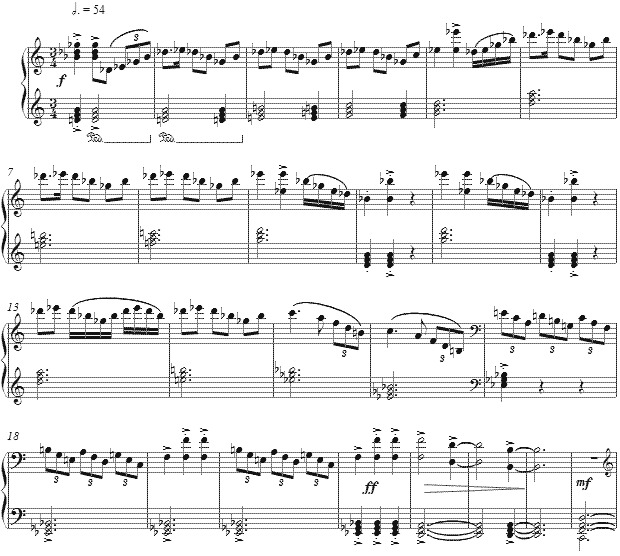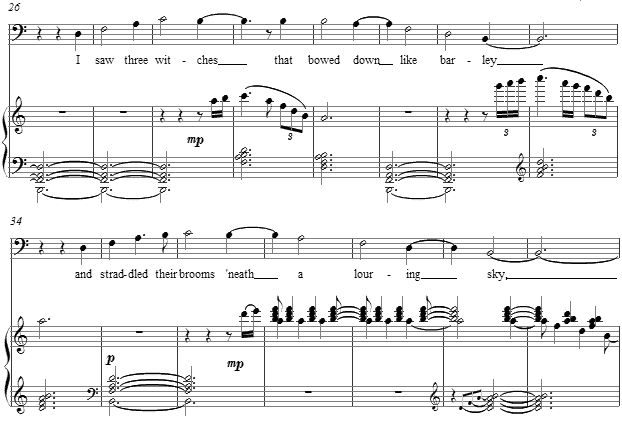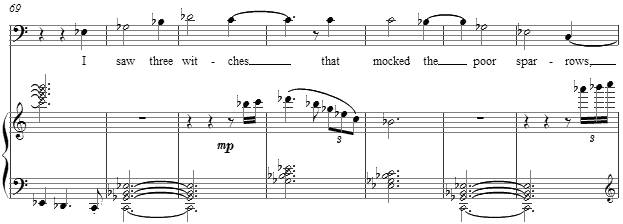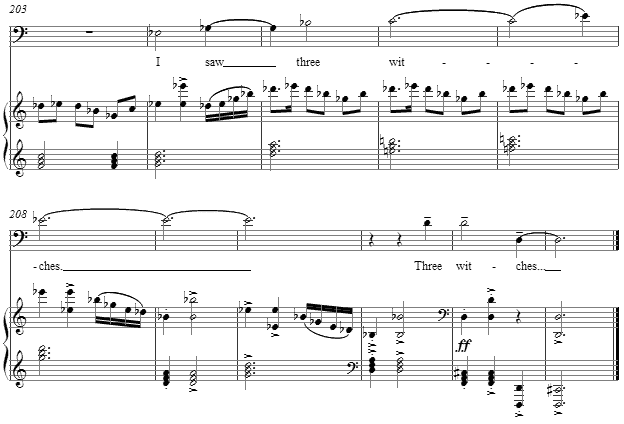Music and Texts of GARY BACHLUND
Vocal Music | Piano | Organ | Chamber Music | Orchestral | Articles and Commentary | Poems and Stories | Miscellany | FAQs
I Saw Three Witches - (2009)
Walter de la Mare
for baritone and piano
for Ro and Michael Hancock-Child
I saw three witches
That bowed down like barley,
And straddled their brooms 'neath a louring [ 1 ] sky,
And, mounting a storm-cloud,
Aloft on its margin,
Stood black in the silver as up they did fly.
I saw three witches
That mocked the poor sparrows
They carried in cages of wicker along,
Till a hawk from his eyrie [ 2 ]
Swooped down like an arrow,
Smote on the cages, and ended their song.
I saw three witches
That sailed in a shallop, [ 3 ]
All turning their heads with a snickering smile,
Till a bank of green osiers [ 4 ]
Concealed their grim faces,
Though I heard them lamenting for many a mile.
I saw three witches
Asleep in a valley,
Their heads in a row, like stones in a flood,
Till the moon, creeping upward,
Looked white through the valley,
And turned them to bushes in bright scarlet bud.[ 8 pages, circa 4' 15" ]
Walter de la Mare
The text is drawn from the collection, Down-adown-derry; a book of fairy poems de la Mare, London, Constable and Co., 1922. Of the many song settings for de la Mare's wondrous poetry this one seems to have escaped significant attention to date. I came across it while reading through much of the poet's work after being asked about my settings by Rosemary and Michael Hancock-Child of Chichester for a recording. The image of the three witches also struck my fancy, as my wife and a dear friend in London are fans of Terry Pratchett's fertile fantasy fiction, in which some most amusing witches may be found. Therefore the text brought certain gestures to mind quickly.
The first image de la Mare paints is of these witches flying against the background of a storm-tossed, dark sky. For this the black-over-white notes of the piano suggested a polytonal dissonance, at once complex and yet simple, as the wee introduction for solo piano. The Klang then becomes E flat minor seven over D minor diatonic for the setting, in which the harmonic movement is in the diatonic.
After this tempest-tossed introduction, the vocal line sings out its testimony, "I saw...." The black note spice disappears as a modal D minor underpins the first verse. Decorative gestures swoop down from above to suggest the movement of these broom-carried witches.
The second verse steps up to the second harmonic domain of E flat minor as implied by the polytonal introduction. Due to the shifting harmonies, no changing key signatures inform as to the domain changes.
The next verse takes up a new domain of C minor with the lowered ninth related to the previous E flat minor, and drops quickly back by common tone modulation in D minor almost immediately. A bridge for the third verse changes the tempo and texture into a lowered emotional rhetoric while the harmonic textures become more chromatic in compensation.
The coda for the setting reprises a shortened version of the introduction over which the vocal line sings out the upper tonal domain of this polytonal texture, before falling solidly back into the tonic as per the first verse at the end, an added C sharp against the octave Ds to darken the final colors.
Ro and Michael Hancock-Child
Ro Hancock-Child read Music at Oxford and has worked for 30 years as a concert pianist and accompanist, artist and author. Her husband Michael, musician and university maths lecturer at Chichester University, studied singing with Brian Rayner Cook, and together they have made CD recordings of English song and piano music (notably Quilter, Armstrong Gibbs and Madeleine Dring) for the Marco Polo and Naxos labels.
The score for I Saw Three Witches is available as a free PDF download, though any major commercial performance or recording of the work is prohibited without prior arrangement with the composer. Click on the graphic below for this piano-vocal score.
NOTES
[ 1 ] Louring - a menacing or dark appearance, as also lower or "elowering." In these alternative spellings and more unusual vocabulary, de la Mare chooses to put us into the frame of a certain archaic mood, wherein language was more savory and complex in colors.
[ 2 ] Eyrie - an alternative spelling for "aerie," the nest of a bird of prey, inaccessible in a high place.
[ 3 ] Shallop - a light boat for rowing in shallow water, from the French, chaloupe, and originally referring to a larger masted vessel, related to the sloop.
[ 4 ] Osier - any of a variety of willow trees with draping branches, from an Old French root related to an earlier Medieval Latin.






